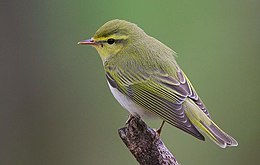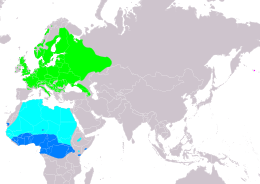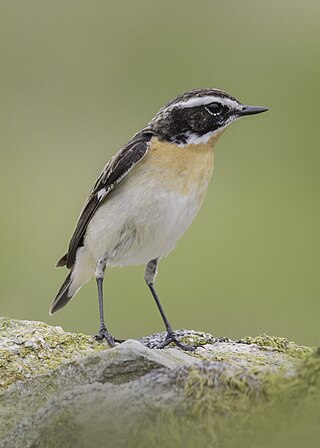
The whinchat is a small migratory passerine bird breeding in Europe and western Asia and wintering in central Africa. At one time considered to be in the thrush family, Turdidae, it is now placed in the Old World flycatcher family, Muscicapidae. Both sexes have a strong supercilium, brownish upper parts mottled darker, a pale throat and breast, a pale buff to whitish belly, and a blackish tail with white bases to the outer tail feathers, but in the breeding season, the male has an orange-buff throat and breast.

The cuckoo, common cuckoo, European cuckoo or Eurasian cuckoo is a member of the cuckoo order of birds, Cuculiformes, which includes the roadrunners, the anis and the coucals.

Leaf warblers are small insectivorous passerine birds belonging to the genus Phylloscopus.
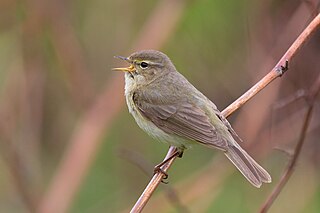
The common chiffchaff, or simply the chiffchaff, is a common and widespread leaf warbler which breeds in open woodlands throughout northern and temperate Europe and the Palearctic.

The willow warbler is a very common and widespread leaf warbler which breeds throughout northern and temperate Europe and the Palearctic, from Ireland east to the Anadyr River basin in eastern Siberia. It is strongly migratory, with almost all of the population wintering in sub-Saharan Africa.

The Arctic warbler is a widespread leaf warbler in birch or mixed birch forest near water throughout its breeding range in Fennoscandia and the northern Palearctic. It has established a foothold in North America, breeding in Alaska. This warbler is strongly migratory; the entire population winters in southeast Asia. It therefore has one of the longest migrations of any Old World insectivorous bird.

The greenish warbler is a widespread leaf warbler with a breeding range in northeastern Europe, and temperate to subtropical continental Asia. This warbler is strongly migratory and winters in India. It is not uncommon as a spring or early autumn vagrant in Western Europe and is annually seen in Great Britain. In Central Europe large numbers of vagrant birds are encountered in some years; some of these may stay to breed, as a handful of pairs does each year in Germany.

Pallas's leaf warbler or Pallas's warbler, is a bird that breeds in mountain forests from southern Siberia east to northern Mongolia and northeast China. It is named for German zoologist Peter Simon Pallas, who first formally described it. This leaf warbler is strongly migratory, wintering mainly in south China and adjacent areas of southeast Asia, although in recent decades increasing numbers have been found in Europe in autumn.

The yellow-browed warbler is a leaf warbler which breeds in the east Palearctic. This warbler is strongly migratory and winters mainly in tropical South Asia and South-east Asia, but also in small numbers in western Europe. Like the rest of Phylloscopidae, it was formerly included in the Old World warbler assemblage.

Hume's leaf warbler or Hume's warbler is a small leaf warbler which breeds in the mountains of inner Asia. This warbler is migratory and winters mainly in India.

The western Bonelli's warbler is a warbler in the leaf warbler genus Phylloscopus. It was formerly regarded as the western subspecies of a wider "Bonelli's warbler" species, but as a result of modern taxonomic developments, they are now usually considered to be two species:

The Eastern Bonelli's warbler, sometimes known as Balkan warbler, is a "warbler" in the leaf warbler genus Phylloscopus. It was formerly regarded as the eastern subspecies of a wider "Bonelli's warbler" species, but as a result of modern taxonomic developments, they are now usually considered to be two species:

The Canada warbler is a small boreal songbird of the New World warbler family (Parulidae). It summers in Canada and northeastern United States and winters in northern South America.

The Canary Islands chiffchaff is a species of leaf warbler endemic to the Canary Islands, Spain. Sometimes the English name is spelled Canary Island chiffchaff.

The Chinese leaf warbler is a species of Old World warbler in the family Phylloscopidae. Its natural habitats are subtropical or tropical dry forests and subtropical or tropical high-altitude shrubland. It is found only in China.

Blyth's leaf warbler is a species of leaf warbler. It was formerly included in the "Old World warbler" assemblage.
Martens's warbler, also known as Omei warbler or Emei Shan warbler, is a species of Old World warbler in the family Phylloscopidae. It was first described in 1999. It is found in China and Myanmar. Its natural habitats are temperate forests and subtropical or tropical moist montane forests.
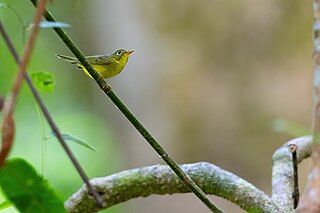
Alström's warbler, or the plain-tailed warbler, is a species of Old World warbler in the family Phylloscopidae. It was first described in 1999. It breeds only in China and winters as far as Thailand, Laos, Cambodia and Vietnam. Its natural habitat is temperate forests.

The limestone leaf warbler is a species of warbler in the family Phylloscopidae. When this species was first seen, beginning in 1994, it was mistaken for the similar sulphur-breasted warbler. It is smaller than the sulphur-breasted warbler, and has more rounded wings. The plumage is almost identical, with comparisons showing only a slightly colder yellow below and a greyer tinge above. Although smaller, the bill is proportionally larger than that of the sulphur-breasted warbler. Accurate measurements are not available; the holotype has a wing length of 5.2 cm (2.0 in); the paratype a tail length of 3.7 cm (1.5 in) and a bill length of 1.39 cm (0.55 in). The species is known to occur in northern Vietnam and Laos, and potentially also occurs in southern China as well. The species name, calciatilis, means "dwelling on limestone", which along with its common name is a reference to its natural habitat, which is broadleaved evergreen and semi-evergreen forest growing around limestone karst mountains. The bare-faced bulbul, described in 2009, was found in the karst of the same region.
The match/mismatch hypothesis (MMH) was first described by David Cushing (1969). The MMH "seeks to explain recruitment variation in a population by means of the relation between its phenology—the timing of seasonal activities such as flowering or breeding - and that of species at the immediate lower level", see Durant et al. (2007). In essence it is a measure of reproductive success due to how well the phenology of the prey overlaps with key periods of predator demand. In ecological studies, a few examples include timing and extent of overlap of avian reproduction with the annual phenology of their primary prey items, the interactions between herring fish reproduction and copepod spawning, the relationship between winter moth egg hatching and the timing of oak bud bursting, and the relationship between herbivore reproductive phenology with pulses in nutrients in vegetation
